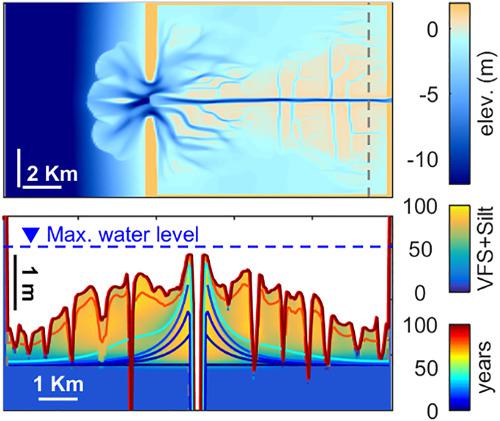当前位置:
X-MOL 学术
›
Earth Surf.Process. Land.
›
论文详情
Our official English website, www.x-mol.net, welcomes your feedback! (Note: you will need to create a separate account there.)
Natural levee evolution in vegetated fluvial‐tidal environments
Earth Surface Processes and Landforms ( IF 3.3 ) Pub Date : 2020-10-01 , DOI: 10.1002/esp.5003 Marcio Boechat Albernaz 1 , Lonneke Roelofs 1 , Harm Jan Pierik 1 , Maarten G. Kleinhans 1
Earth Surface Processes and Landforms ( IF 3.3 ) Pub Date : 2020-10-01 , DOI: 10.1002/esp.5003 Marcio Boechat Albernaz 1 , Lonneke Roelofs 1 , Harm Jan Pierik 1 , Maarten G. Kleinhans 1
Affiliation

|
Abstract Natural levees are common features in river, delta and tidal landscapes. They are elevated near‐channel morphological features that determine the connection between channel and floodbasin, and consequently affect long‐term evolution up to delta‐scales. Despite their relevance in shaping fluvial‐tidal systems, research on levees is sparse and often limited to fluvial or non‐tidal case studies. There is also a general lack of understanding of the role of vegetation in shaping these geomorphic units, and how levee morphology and dimensions vary in the transition from fluvial to coastal environments, where tides are increasingly important. Our goal is to unravel the effects of fluvial‐tidal boundary conditions, sediment supply and vegetation on levee characteristics and floodbasin evolution. These conditions were systematically explored by 60 large‐scale idealized morphodynamic simulations in Delft3D which self‐developed levees over the course of one century. We compared our results to a global levee dataset compilation of natural levee dimensions. We found that levee height is determined by the maximum water level, provided sufficient levee building sediments are available. Discharge fluctuations increased levee width and triggered more levee breaches, i.e. crevasses, that effectively filled the fluvio‐tidal floodbasin. The presence of wood‐type (sparse) vegetation further increased the number of crevasses in comparison with the non‐vegetated scenarios. Conversely, reed‐type (dense) vegetation strongly dampened tidal amplitude and reduced the accommodation space and sedimentation further into the floodbasin, resulting in narrower levees, no crevasses and limited floodbasin accretion. However, dense vegetation reduced tidal forces which allowed levee growth further downstream. Ultimately, the levees merged with the coastal barrier, eliminating the floodbasin tides entirely. Our results elucidate the mechanisms by which levee and crevasse formation, and vegetation may fill fluvio‐tidal wetlands and affect estuary evolution. This brings new insights for geological reconstructions as well as for the future management of deltas and estuaries under sea‐level rise. © 2020 The Authors. Earth Surface Processes and Landforms published by John Wiley & Sons Ltd
中文翻译:

植被河流潮汐环境中的天然堤防演变
摘要 天然堤坝是河流、三角洲和潮汐景观的共同特征。它们是升高的近河道形态特征,决定了河道和洪泛区之间的联系,从而影响到三角洲尺度的长期演化。尽管它们在塑造河流-潮汐系统方面具有相关性,但对堤坝的研究很少,而且通常仅限于河流或非潮汐案例研究。也普遍缺乏对植被在塑造这些地貌单元中的作用以及堤坝形态和尺寸在从河流到沿海环境的过渡中如何变化的理解,在那里潮汐变得越来越重要。我们的目标是阐明河流潮汐边界条件、沉积物供应和植被对堤坝特征和流域演变的影响。这些条件是通过 Delft3D 中的 60 个大规模理想化形态动力学模拟系统地探索的,这些模拟是在一个世纪的过程中自行开发的堤坝。我们将我们的结果与天然堤坝尺寸的全球堤坝数据集汇编进行了比较。我们发现,只要有足够的堤坝建筑沉积物可用,堤坝高度由最高水位决定。流量波动增加了堤防宽度并引发了更多堤防破坏,即裂缝,有效地填充了潮汐流域。与非植被情景相比,木型(稀疏)植被的存在进一步增加了裂缝的数量。相反,芦苇型(密集)植被强烈地抑制了潮汐振幅,并减少了进一步进入洪泛区的容纳空间和沉积物,导致堤坝变窄,没有裂缝,洪泛区淤积有限。然而,茂密的植被降低了潮汐力,使堤坝在下游进一步生长。最终,堤坝与海岸屏障合并,完全消除了流域潮汐。我们的研究结果阐明了堤坝和裂缝形成以及植被可能填充潮汐湿地并影响河口演化的机制。这为地质重建以及未来海平面上升下三角洲和河口的管理带来了新的见解。© 2020 作者。John Wiley & Sons Ltd 出版的地球表面过程和地貌 彻底消除流域潮汐。我们的研究结果阐明了堤坝和裂缝形成以及植被可能填充潮汐湿地并影响河口演化的机制。这为地质重建以及未来海平面上升下三角洲和河口的管理带来了新的见解。© 2020 作者。John Wiley & Sons Ltd 出版的地球表面过程和地貌 彻底消除流域潮汐。我们的研究结果阐明了堤坝和裂缝形成以及植被可能填充潮汐湿地并影响河口演化的机制。这为地质重建以及未来海平面上升下三角洲和河口的管理带来了新的见解。© 2020 作者。John Wiley & Sons Ltd 出版的地球表面过程和地貌
更新日期:2020-10-01
中文翻译:

植被河流潮汐环境中的天然堤防演变
摘要 天然堤坝是河流、三角洲和潮汐景观的共同特征。它们是升高的近河道形态特征,决定了河道和洪泛区之间的联系,从而影响到三角洲尺度的长期演化。尽管它们在塑造河流-潮汐系统方面具有相关性,但对堤坝的研究很少,而且通常仅限于河流或非潮汐案例研究。也普遍缺乏对植被在塑造这些地貌单元中的作用以及堤坝形态和尺寸在从河流到沿海环境的过渡中如何变化的理解,在那里潮汐变得越来越重要。我们的目标是阐明河流潮汐边界条件、沉积物供应和植被对堤坝特征和流域演变的影响。这些条件是通过 Delft3D 中的 60 个大规模理想化形态动力学模拟系统地探索的,这些模拟是在一个世纪的过程中自行开发的堤坝。我们将我们的结果与天然堤坝尺寸的全球堤坝数据集汇编进行了比较。我们发现,只要有足够的堤坝建筑沉积物可用,堤坝高度由最高水位决定。流量波动增加了堤防宽度并引发了更多堤防破坏,即裂缝,有效地填充了潮汐流域。与非植被情景相比,木型(稀疏)植被的存在进一步增加了裂缝的数量。相反,芦苇型(密集)植被强烈地抑制了潮汐振幅,并减少了进一步进入洪泛区的容纳空间和沉积物,导致堤坝变窄,没有裂缝,洪泛区淤积有限。然而,茂密的植被降低了潮汐力,使堤坝在下游进一步生长。最终,堤坝与海岸屏障合并,完全消除了流域潮汐。我们的研究结果阐明了堤坝和裂缝形成以及植被可能填充潮汐湿地并影响河口演化的机制。这为地质重建以及未来海平面上升下三角洲和河口的管理带来了新的见解。© 2020 作者。John Wiley & Sons Ltd 出版的地球表面过程和地貌 彻底消除流域潮汐。我们的研究结果阐明了堤坝和裂缝形成以及植被可能填充潮汐湿地并影响河口演化的机制。这为地质重建以及未来海平面上升下三角洲和河口的管理带来了新的见解。© 2020 作者。John Wiley & Sons Ltd 出版的地球表面过程和地貌 彻底消除流域潮汐。我们的研究结果阐明了堤坝和裂缝形成以及植被可能填充潮汐湿地并影响河口演化的机制。这为地质重建以及未来海平面上升下三角洲和河口的管理带来了新的见解。© 2020 作者。John Wiley & Sons Ltd 出版的地球表面过程和地貌



























 京公网安备 11010802027423号
京公网安备 11010802027423号